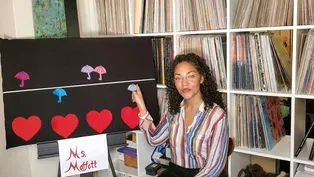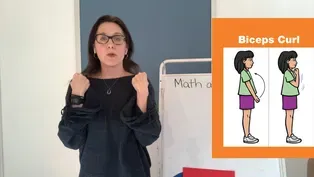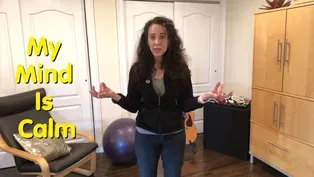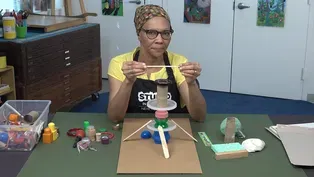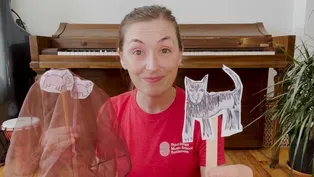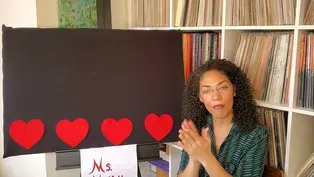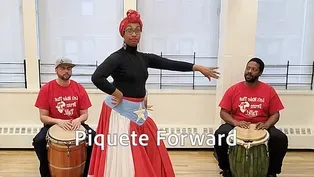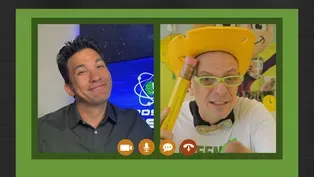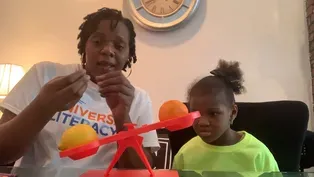
What Sounds Do You Hear in “Splash”?
3/3/2021 | 56m 51sVideo has Closed Captions
Draw shapes you find at home, use + to write an addition equation, read JABARI JUMPS.
Draw shapes and colors you find at home, use + to write an addition equation, read JABARI JUMPS, decode initial blends with s. LET’S LEARN helps children ages 3-8 with at-home learning. One-hour programs feature instruction by educators and virtual field trips.
Problems with Closed Captions? Closed Captioning Feedback
Problems with Closed Captions? Closed Captioning Feedback
Let's Learn is a local public television program presented by THIRTEEN PBS

What Sounds Do You Hear in “Splash”?
3/3/2021 | 56m 51sVideo has Closed Captions
Draw shapes and colors you find at home, use + to write an addition equation, read JABARI JUMPS, decode initial blends with s. LET’S LEARN helps children ages 3-8 with at-home learning. One-hour programs feature instruction by educators and virtual field trips.
Problems with Closed Captions? Closed Captioning Feedback
How to Watch Let's Learn
Let's Learn is available to stream on pbs.org and the free PBS App, available on iPhone, Apple TV, Android TV, Android smartphones, Amazon Fire TV, Amazon Fire Tablet, Roku, Samsung Smart TV, and Vizio.
Providing Support for PBS.org
Learn Moreabout PBS online sponsorshipMore from This Collection
Video has Closed Captions
Read SCHOOL BUS and draw one, learn about prefixes and pitch, build sculptures. (57m 48s)
Running and Counting Both End in “ing”!
Video has Closed Captions
Move to improve, find the missing number, learn songs from Ghana, read ABUELITA’S SECRET. (58m 17s)
What Sound Does “aw” Make in Draw?
Video has Closed Captions
Read a story, discover "au" and "aw," learn about density, count, and move with music. (56m 58s)
Can You Find the Short “u” in Subtract?
Video has Closed Captions
Help Super Grover 2.0 solve a prickly problem, read ALL THE WAYS TO BE SMART. (56m 19s)
What Sound Does “gl” Make in Glove?
Video has Closed Captions
Play the glockenspiel, help Super Grover 2.0 make a cart move, read TWO WOOL GLOVES. (58m 9s)
Incredible Starts with Short “i”!
Video has Closed Captions
Solve problems with Super Grover 2.0, catch a rainbow, hear a piano sound like a cuckoo. (56m 9s)
What’s the Sound of “oo” in Book?
Video has Closed Captions
Explore animals’ form and function, sing about the 3 little pigs, read THE LITTLE BOX. (58m 15s)
We’re Reducing, Reusing and Recycling!
Video has Closed Captions
Learn all about rhythm and the number 9, read A BAG IN THE WIND. (56m 17s)
Video has Closed Captions
Learn to dance bomba and grow food in a city, read WOLF CUB’S SONG. (55m 20s)
How Many Syllables are in Invent?
Video has Closed Captions
Invent your own instrument, make 10 to add numbers to 20, read ONE GOLDEN RULE AT SCHOOL. (57m 36s)
Video has Closed Captions
Learn about the science behind mind reading, count shells, read MY BIG FAMILY. (57m 27s)
Which is Heavier: One Apple or Two Apples?
Video has Closed Captions
Defy gravity, learn secret code words for fast and slow in music, read WHOOO KNEW? (58m 5s)
Providing Support for PBS.org
Learn Moreabout PBS online sponsorship[playful music] - [Narrator] Ready to learn?
- Hi!
- Hi!
- [Narrator] It's time to share a story, read and write.
- Let's read it back.
- [Narrator] Discover science.
Sing.
♪ Somewhere ♪ - [Narrator] Play, and so much more.
- Cupcake!
- Very good.
- [Narrator] Stay tuned for lessons and activities.
- We're gonna start making some words.
Isn't that fun?
[playful music] - [Narrator] Funding for this program was provided by the JPB Foundation.
[playful music] - Hi, my name's Mandy And I'm a teaching artist for the New York City Children's Theater.
And today, I'm gonna share with you one of my favorite books, Jabari Jumps.
Written and illustrated by Gaia Cornwall.
Right there, that little boy.
That's the main character in our story.
His name is Jabari.
Say hi, Jabari.
Hi Jabari.
So what do you see?
Where do you think Jabari is today in our story?
I see trees and tall buildings.
And wait, what do you think this is here?
What is that?
Do you think you know?
I mean, I guess we'll see soon.
Jabari Jumps is a story about being brave.
Now, brave is when you do something even though you might feel a little scared or maybe it's a little difficult to do.
I bet you've been brave and scared before.
Can you show me?
What does it look like on your face and body when you're scared?
Show me your scared face.
Do you have scared eyes?
Little, maybe scared, scared hands.
I don't know.
You're so scared.
Show me scared.
Good job.
What does it look like to be brave?
What does it look like in your face and body when you are ready?
I am ready.
You can do this thing even though you might be a little scared, you are ready.
Good job.
Now, relax, relax.
Show me your most relaxed face.
How do you feel when you're relaxed and calm?
Oh, just kick back and relax.
You look very relaxed, good.
Now, can you show me what it looks like to feel proud that you have done something that maybe you worked hard on and you have accomplished it.
You are proud.
Maybe you give me a thumbs up.
Are you proud?
Good.
Now show me what it looks like to feel excited.
Maybe you have excited fingers and you're a little excited face.
Show me your most excited face and body.
That's great.
Now, I hope you're excited to play a little game with me.
Kind of like Simon Says.
I'm gonna say a feeling.
One of the ones we just practiced and you're gonna show me that feeling in your face and body, whatever that looks like to you.
Okay, ready?
Show me brave.
Go ahead.
I want you to be the most brave that you can be.
Show me excited.
You never know what I'm gonna say.
Looks good.
Show me relaxed.
Most relaxed face and body.
Show me scared.
Show me brave.
Show me proud.
So are you keeping up?
[laughs] Show me brave.
That's right.
We're gonna end with that one for now.
And let's see what Jabari was being brave about in his story.
Jabari Jumps.
"I'm jumping off the diving board today."
Jabari told his dad.
"Really?"
said his dad.
He looks ready.
The diving board was high and maybe a little scary but Jabari had just finished his swimming lessons and he passed the swim test.
So now, he was ready to jump.
"I'm a great jumper," said Jabari.
"So I'm not scared at all."
Does he look scared to you?
That doesn't look like a scared face and body to me.
I think he's ready.
We'll see.
Jabari watched the other kids climb the long ladder.
They walked all the way out to the end of the board and they looked as big as tiny bugs.
And then they stood on the edge and they spread their arms and they bent their knees and they sprang up.
Up, up, up.
And then they dove down, down, down and splash into the water.
Say that with me, splash make that sound.
Did you know that splash is an onomatopoeia?
Do you know what that is?
An onomatopoeia is a word that sounds and looks like the way that it sounds.
So like it's spelled like the way it sounds.
Let me show you.
How about whoosh.
Can you say that with me?
Whoosh, Whoosh, W-H-O-O-S-H. Whoosh.
It's spelled like, and it looks like the way that it sounds, whoosh.
Maybe we'll hear that sound in the book again.
Kind of sounds like a water sound.
Whoosh.
Let's look at another one.
Plop.
Plop is another onomatopoeia.
You see it spelled like it kind of sounds plop.
Plop.
Can you make the plop sound with me?
How about a big plop?
Plop.
Like a little plop, plop.
Oh, that's a fun sound.
Make the tiniest tiniest tiniest plop that you can.
[makes tiny plop sounds] Great job.
Onomatopoeias are really fun to say.
I wonder what other words you might know that are onomatopoeia?
That are spelled and look like the way that they sound.
Keep your eyes out for them when you read.
Now, let's get back to splash.
"That looks easy," Jabari said.
But when his dad's squeezed his hand, Jabari squeezed right back.
Jabari stood at the bottom of the ladder and he looked up.
Let's all look up up up at that very long ladder.
"Hmm.
You can go before me if you want."
He told the kid behind him.
I need to think about what kind of special jump I'm going to do.
Jabari thought and thought and thought.
What do you think he's thinking about?
Jabari started to climb up and up.
"The ladder is very tall," he thought.
"Are you okay?"
Said his dad.
"I'm just a little tired," said Jabari.
"Well, maybe you should climb down and take a tiny rest."
Said his dad.
A tiny rest sounded like a good idea to Jabari.
So when he got to the bottom, Jabari remembered something.
"Oh, oh, I forgot to do my stretches."
He said to his dad.
And I wonder why do you think Jabari wants to do stretches right now?
He was already at the top of the ladder.
Do you think that he wants some time to think?
Maybe he's trying to get his courage together to be brave and to do the scary thing?
Or maybe he needs to get his body ready right now.
Can you get ready with Jabari and me now?
Let's all stretch a little bit and get our bodies ready.
To the side.
To the side.
And touch your toes.
Your toes.
And then he's stretching his arms.
Show me an arm stretch.
Now show me and Jabari.
What sort of stretch would you like to do to get ready?
Show me.
Very nice, very nice "Stretching is very important," said his dad.
"I think tomorrow might be a better day for jumping."
Jabari said.
And they looked up at the diving board together.
"It's okay to feel a little scared."
Said his dad.
"Sometimes I feel a little scared.
And I take a deep breath and tell myself I am ready.
And you know what?
Sometimes, it stops feeling scary and it feels a little like a surprise."
Jabari loves surprise.
So Jabari took a deep breath and it felt like it filled his body from the ends of his hair right down to the tips of his toes.
Let's take a deep breath with Jabari now.
Right from the ends of your hair and down to the tips of your toes.
It's so deep.
[exhales] Very nice.
Jabari looked up and he began to climb up and up and up and up.
"I am ready."
Maybe he's saying that to himself.
"I am ready."
Until he got to the top.
Jabari stood straight up.
"I am ready" Can you say it with him?
I am ready.
He walked all the way to the end of the board.
"I am ready, I am ready."
And his toes curled around the rough edge of the diving board.
Let's all look down with Jabari at the big, blue pool.
Far away.
Hello, everybody down there.
How do you think Jabari feels now?
Jabari looked out for as far as he could see.
He felt like he was ready.
"I love surprises," he whispered.
Wow.
He took a deep breath and spread his arms and bent his knees.
Then he sprang up, up up the board, flying.
Wow.
Jabari hit the water with a splash.
Let's all make that sound, splash.
Down, down, down, he went.
And went back up with a whoosh.
Let's now make that sound with Jabari.
Whoosh.
"Jabari, you did it!"
said his dad.
"I did it!"
Said Jabari.
"I'm a great jumper.
And you know what?"
"What?"
said his dad.
He's so excited.
"Surprise doubled back flip is next."
Wow.
That's so cool.
Now think about a time that you had to do something that maybe you were a little scared of or was a little new to you and you had to be brave.
I mean, we all have to try something for the first time.
There's a first time for everything.
Do you have something in your life right now that maybe you're a little nervous or scared to try to do for the first time?
Like Jabari jumping off the diving board.
Let's think.
Maybe you wanna ride a bike for the first time or go down the big slide.
Yeah, think of something.
If there's something that you need to be brave about?
Do you have it yet?
Okay.
Now imagine you're doing this thing for the first time.
Riding a bike or going down the big slide or maybe you have a big test coming up and you've never had to do that before.
Imagine you were about to do it.
Now, I'm gonna get up with you for this.
I want you to give me your most brave face and body and say, I am ready.
We're gonna do that three times.
Do it with me now.
I am ready.
Two more times.
I am ready.
One more time.
I am ready.
Yes, you are ready.
I believe in you.
You can do this.
So now, we're gonna celebrate Jabari's bravery with a dance.
And all the dance moves are gonna be made up of swimming moves but don't worry.
You don't really have to know how to swim in order to do this dance.
You'll see.
Okay.
Now, since we're gonna be swimming and dancing around, make sure that there's nothing around you that you're gonna bump into like this chair.
Make sure you're in a safe space to bounce around.
All right.
We're gonna learn move number one for our dance.
The swim up.
It's called the up, up, up.
So you take your little hands and you're gonna paddle up.
Just like when he came up the water, up, up, up, up, up.
Ready?
Do that with me.
Up, up, up, up, up, up.
One more time.
Up, up, up, up, up, up.
They're like little scoops.
Move number two.
It's a pretty good one.
It's called a doggy paddle.
Have you seen a dog?
Get your paws ready.
And you're gonna do the doggy paddle.
Paddle paddle paddle paddle paddle paddle.
Are you doing it with me?
Paddle paddle paddle paddle paddle paddle paddle.
Good, good doggy paddle.
Whatever makes it work for you.
Move number three is the long stroke.
You're gonna use all of your arm to pull as much water away from you as you can.
Long stroke, long stroke, long stroke.
Whoosh.
Oh, we can use our onomatopoeia sound with this.
Whoosh, whoosh, whoosh, whoosh.
Good job with the long stroke.
Move number four.
It's called the wiggle down down.
And the reason it's called the wiggle down down is because you hold your nose and you're going down in the water with wiggle down, down, down, down.
A wiggle down, down, down, down, down.
Do it two more times if you're ready.
Hold your nose.
You're gonna go down the water.
A wiggle down, down, down, down, down.
A wiggle down, down, down, down, down.
All right.
You got those four moves.
Let's put them all together into one dance.
Now please do this with me.
It'll be a synchronized dance here.
All right.
Are you ready?
[laughs] Three, two, one.
Up up up up up up.
Paddle paddle paddle paddle paddle paddle paddle.
Long stroke, long stroke.
Wiggle down, down, down.
Wiggle down, down, down.
Up up up up up up.
Paddle paddle paddle paddle paddle paddle paddle.
Whoosh, whoosh, whoosh, whoosh.
Wiggle down, down, down.
Wiggle down, down, down.
[laughs] Good job.
Oh man.
Dancing is a great way to celebrate.
Now I wonder.
What dance move would you wanna add to this now?
Can you think of another swimming move all your own?
Like the cannon ball?
What would the cannon ball look like?
What would the splash look like?
So I want you to make up your own dance moves now.
I see if anybody else in your home wants to learn it with you and then you all can be doing your synchronized dance together.
All to celebrate Jabari's bravery today and Jabari's big jump.
Thank you so, so much for exploring this story with me.
- Hi, movers and shakers.
This is violet and this is my sister Ivy.
- Hi.
- Today, we're gonna sing a song with you called My Aunt Came Back.
It has a pattern in it.
And I wonder if you can hear it by the end.
So this is a call and response song.
That means I'm gonna sing the words and you're gonna repeat after me.
And Ivy is going to sing that part with you.
But there are also movements that go with each verse.
So look at us and you can do the movements along with us and you can do that sitting up, standing up, sitting on the floor, however you want to.
All right, so we're gonna sing the song.
Are you ready?
Okay.
♪ My aunt came back ♪ ♪ My aunt came back ♪ ♪ From Kalamazoo ♪ ♪ From Kalamazoo ♪ ♪ And she brought with her ♪ ♪ And she brought with her ♪ ♪ A wooden shoe ♪ ♪ A wooden shoe ♪ ♪ My aunt came back ♪ ♪ My aunt came back ♪ ♪ From the New York fair ♪ ♪ From the New York fair ♪ ♪ And she brought with her ♪ ♪ And she brought with her ♪ ♪ A rocking chair ♪ ♪ A rocking chair ♪ ♪ My aunt came back ♪ ♪ My aunt came back ♪ ♪ From the Jersey shore ♪ ♪ From the Jersey shore ♪ ♪ And she brought with her ♪ ♪ And she brought with her ♪ ♪ An apple core ♪ ♪ An apple core ♪ ♪ My aunt came back ♪ ♪ My aunt came back ♪ ♪ From Timbuktu ♪ ♪ From Timbuktu ♪ ♪ And she brought with her ♪ ♪ And she brought with her ♪ ♪ Some friends like you ♪ ♪ some friends like you ♪ [playful music] - Hi there.
I'm Erica.
Thanks for joining me today.
We are going to be having some fun with words.
We're learning all about consonant blends beginning with the letter S. We will be reading words, going on a word hunt, spelling words, and sorting words with the new sounds and [indistinct] we're learning.
So we have so much to do.
We need to get started right away.
Are you ready?
Let's go.
Here's a picture of a stove.
And here's the word stove.
When I say that word, I hear two consonant sounds at the beginning.
S, T. The letters S and T underlined here stands for those sounds.
St, stove.
They form a consonant blend.
In a consonant blend, each letter stands for its own sound but we say the really close thing together.
So you have to really train your ears to hear it.
Say that word again with me.
Stove.
Great.
Let's take a look at some other consonant blends.
Here's a picture of a slide.
I love going down the slide.
Say that word.
Slide.
Yes.
The S and the L are the consonant blend in this word.
Sl, slide.
Here's a picture of a cute little snail.
S and N form the consonant blend there.
Sn, snail.
And in the word spoon, the consonant blends is formed by the letters S and P. Sp, spoon.
Great.
Another piece of playground equipment is a swing.
Sw, swing.
S and W are the consonant blends there.
Now sometimes, three consonants can come together to form a blend.
It has a special name called a trigraph.
Take a look at the picture here of a splash.
In the word splash, S, P and L come together to form that three consonant blends or trigraph.
Another trigraph is S, T, R as in the word straw.
And here's a picture of a straw.
Those were a lot of consonant blends.
I think that you're ready to read some words with them.
I'm going to be pointing at all of our words here.
Have consonant blends beginning with the letter S and we'll blend the sounds together to read the word.
Why should I do the first one?
S, t. Put those together.
St, it's our consonant blend.
We have a short vowel i sound here.
Sti, sti.
And our digraph, ck.
Stick.
Faster.
Stick.
Great.
Try this one with me.
Sk.
Put that constant and blend together.
Sk.
Great.
Short vowel i again, i.
Ski, ski.
Last consonant, D. Skid.
Quickly.
Skid.
Skid means when a vehicle like a car or a truck, suddenly slides.
We can say that the car or the truck skid.
I think you're ready to try this one on your own.
I'll point and slide my finger under to remind you to blend.
Put that consonant blend together.
The vowel sound.
Put that together.
Last consonant sounds, blend it all.
Read the word.
Did you say slam?
Yes.
Let's try this last word.
You're right.
It has our trigraph.
S, P, L as in splash.
Put the trigraph together.
Vowel sound.
Put all of that together.
Our last consonant sound.
Blend it, split.
Yes, great.
Okay.
Are you ready to use those eyes to spot?
Hey, spot.
I used a blend.
Yeah, we're gonna be spotting some words.
I'm going to give you some clues and one or maybe two of the words will answer that clue.
And it's your job to spot them.
Are you ready?
Here's your first clue.
I'm looking for a word that begins with a consonant blend that sounds like sp.
Blend the word and shout it out.
Yes, it's the words spot.
Great.
Here's your next clue.
I'm looking for a word that has a consonant blend at the beginning but has a double consonant at the end.
A double constant means it has the same consonant at the end.
You found it.
Skill.
It has two L's at the end.
And Sk is the consonant blend.
Now I'm looking for two words.
Two words that contain a trigraph.
Remember, these are our trigraphs.
You see two words up here with trigraphs?.
Shout them out.
Yes, strap and splat.
Last clue.
I'm looking for two words again that begin with the consonant blend st, st.
Which two letters stand for those sounds?
S and T, great.
What are the words?
Stuck and stop.
You guys didn't get stuck on that.
Now I think you're ready to spell.
Hey, another constant blend.
Sp, spell.
I'm going to do the first one.
And if you want to do the rest with me, make sure you get something to write with and something to write on.
Are you ready?
Okay, here's our first word.
I'm gonna stretch it out.
Sniff, sniff.
And I'm stretching out so I can really hear those consonant blends.
S, I know it's going to begin with S. N stands for that sound.
Yes, it has two consonants at the end.
Just like skill.
Try this next one with me.
Stuck.
Stuck.
S. Yes, St, just like in stove.
U and the digraph, ck.
I think you're ready to try this one all by yourself.
If you can spell, stuck, try struck.
You're right.
It does have a trigraph, just like in straw.
Shout out the letters as soon as you're done.
Yes, you're right.
S-T-R-U-C-K. Great.
I'm going to underline all of those blends so far.
Here's our last word.
It's a itty bitty word.
Sled.
Stretch it out if you need to.
Sled.
Shout out the letters.
Great.
S-L-E-D. We're ready for our last activity.
So I'm going to slide our board.
I did it again, slide.
I used another consonant blend.
The last activity is our word sort.
I've written two words up here, stop and strap.
And then I will show you some other words and we will read them together.
If the words have a two consonant blends like in stop, has an S and a T, we will place the words in this column.
If it has a trigraph like strap, then we'll place the words in this column.
It won't just only be S and T. It can be any of our consonant blends that just have two consonants.
So you can look up here to remind you and I listed them down here on the side as well.
For this side, it can be S, T, R, that trigraph or it can also be the trigraph S, P, L as in splash.
I'll do the first one.
And you can join me for the rest.
Here's the word step.
St, step.
Yes, St is the consonant blends here just like in stop.
I'll place it in this column.
Try this one with me.
Strut, strut.
Yes, it has that trigraph.
Strut means when you walk in a very proud way.
Maybe you've seen like a peacock.
It might strut and show all its beautiful tail feathers.
Here's the word spit.
Yes, the consonant blend is sp.
Just two, so it goes on this side.
Our next word is snap.
Sn, snap.
Yes.
Just like stop, just two consonants.
Swim, swim.
Another one for this column.
Skin.
Sk is the consonant blend, skin.
Just like in stop.
Two consonants at the beginning.
Here's our last one.
Slid, slid.
You guys did an amazing job with our word sort.
Poor strut, was left here all by itself.
So we're running out of time.
But what I want you to do now is to think of other words that might have trigraph so we can fill up this column.
And be on the lookout for other consonant blends that we've learned today.
St, sp, sw. Any of these that we've had today.
You all did a swell job.
Did you hear that?
I think we get all full of consonant blends.
Thanks for joining me.
Bye.
[playful music] Hi, I'm Trinette.
- Hi, My name is Skylar.
- And we're so happy to be working with you all for today's lesson.
You will need some materials before we begin.
Skylar, can you tell them what we will need today?
- We will need to ask a trusted adult to guide our.
Ask a trusted adult to help you get a sheet of paper and pencil.
- Perfect.
You have 20 seconds to gather those things.
Ready, set, go.
One, two, three, four, five, six, seven, eight, nine, 10, 11, 12, 13, 14, 15, 16, 17, 18, 19, 20.
Perfect.
Now I hope you have those materials.
Put them to the side.
Skylar here is going to kindergarten in a couple of months.
Next year, actually, September.
And she's already prepared.
She already has her backpack with a bunch of school supplies.
It's pretty heavy.
Now, one thing she would definitely need in kindergarten are what?
What are these?
- Pencil.
- Pencil.
So I'm going to give Skylar four pencils.
How many pencils did I say?
Four.
Can you hold those four pencils?
And then I'm going to give her two more pencils.
How many do we have here?
Two.
So let's take a look at my chart.
Skylar has four pencils in one hand.
That would be this hand.
And two pencils in the other hand.
Now, I have up here, something called the plus sign.
Can I hold a pencils?
Thank you.
What sign do we call this?
- Plus sign.
- The plus sign.
Some people also call it the addition sign.
Can you say that with me?
- Addition sign.
- Addition sign.
So now, when we use this sign, Skylar and learners at home, we're putting things together.
What are we doing?
- Putting things together.
- Putting things together.
So let's take a look at this.
Skylar has four pencils.
So I'm gonna write four.
What do we call this?
- Plus.
- Plus.
And Skyler have how many more pencils?
Two.
Let's take a look.
So what am I gonna put here?
Two.
Repeat after me.
- Four plus two.
- Four plus two.
Say it again, learners.
- Four plus two.
- Four plus two.
Right now, we don't wanna know how much it gives me at all but this is called an addition expression.
Can you say that?
- Addition expression.
- Addition expression.
Let's try some other examples.
Skyler also has some, what do we call these?
- Cool addition.
- No, what do we call these?
Notebooks, right?
These are notebooks.
So I'm going to give Skylar how many notebooks?
Can we count?
How many is that?
- One and two.
- One and two.
Perfect.
So I'm gonna take my marker.
And I'm gonna write the number two.
Now I'm also going to give Skylar a few more.
Skylar, can you count them?
- One.
Two.
And three.
- Three, perfect.
Keep those right there.
Let's take a look at this, Skylar, learners at home, let's take a look.
Two.
- Two.
- And three.
- And three.
- But now, we wanna write an addition expression.
So I need my, what do we call this symbol?
- Plus sign.
- Plus sign.
So, let's do it together.
Two.
- Two.
- Plus three.
- Plus three.
- That's my addition expression.
Skylar, what else do we have in this book bag?
What are these?
What do we call these?
What did we call them?
- Eraser.
- Did you hear her?
Eraser.
So now, let's see if I can pull them all out of her beautiful backpack.
- There are a lot in there.
- There are a lot.
Okay, so here's what we're gonna do with this one.
I'm going to give Skylar how many erasers?
How many is this?
- One.
- One, hold that one eraser.
And I'm going to write down what number?
- One.
- One.
And actually, let's put it here.
One.
And then let's see how many more I have.
Count with me.
One, two, three, four.
Skylar, in the other hand, hold your four erasers.
So I'm gonna write down the number.
- I have a lot.
- Four.
Let's read this together, learners.
- One and four.
- One and four But now, we need an addition expression.
So what are we gonna put here, learners?
Did you say one?
- One.
- Yes.
What is this sign called?
- Plus sign.
- Plus sign.
- Or addition sign.
- And then what number we're gonna put here?
- Four.
- Four.
Okay, hand mommy the erasers.
Thank you.
So she gave me the one and can I have the other four?
One, no the one, two, three, we lost one.
And four.
Perfect.
So let's read it together.
One plus four.
- One plus two.
- No, let's look again.
Learners, follow along.
- One plus.
- Two.
Four.
- Let's do it again, learners.
Listen to mommy.
One plus four.
Let's all do it.
- One plus four.
- One plus four.
Because we had one eraser and then we had four more.
Okay, let's see what else, Skylar has.
Nothing else left in the bag.
But some other supplies that we need when we go to kindergarten is maybe some paints.
So here's what I'm going to do.
I have some jars of paint.
Let's count.
- One, two.
- One, two.
So Skylar's going to just place those two jars there.
- I like paints.
- So do I.
And then I'm going to give Skylar, let's take a look.
How many more?
Let's count.
- Four.
- Four.
One, two, three, four.
Okay, so let's put those here.
Let's take a look at our chart.
So we have two and four.
So watch quietly.
Two and four.
We need to write an addition expression, which means we need what symbol?
- Plus.
- Plus.
So Skylar is going to write two plus four.
Go ahead.
Two.
Good.
Plus.
And four.
So that is our addition expression.
Two plus four.
Okay, so Skylar, we're gonna turn that four around.
Please take a seat.
That's okay.
Sometimes, that's okay.
Sometimes we write the numbers backwards.
So we're just going to fix it.
Take a seat so the learners can see.
That's a great job.
Two plus four is our addition expression.
Learners, so the next activity, you will use the materials that you gathered earlier.
I have my dry erase board here and I'm gonna use a marker.
You can use whatever it is that you gathered.
This is what we're going to do.
Skylar will show us some of the blocks that she has.
And we're gonna use the blocks to write an addition expression.
Skylar, can you show the learners at home how many white blocks you have?
- I have one and two.
- Okay, stack them.
Now, can you show them how many blue blocks you have?
- One and two.
- Could you stack those?
Perfect.
No, we're not gonna stack them like that.
Do like this.
Okay, so now, take your pencil or whatever you have.
And I want you to write two for the two blue blocks and two for the two white blocks.
Now let's write an additional expression together.
Two.
What symbol or sign do we put here?
- Plus.
- Plus, just like that.
Great.
So two plus two.
Great.
Let's do another one together.
Skylar's gonna show some more blocks.
I'm going to erase what I have.
Skylar, what blocks do you have now?
Can you show us?
What color are they?
- Oh I have one, two.
- We'll count this as one.
This is one whole block.
So you have one and what?
Two.
Okay, so put that on the side.
How many of these you have?
- One.
- One.
So let's take what Skylar has.
She had two.
And she had what?
- One.
- No, let's show the learners.
Two and one.
Now, so you got your pencils.
What should you put here?
Let's not tell them.
How many does she have?
Great, let's put two.
I have it.
And how many do you have here Skylar?
- One.
- Okay, you go write the number one over there.
I got.
Write the number one here.
Right here.
Learners, you do it as well.
Two and one.
- I have a fancy one.
- Perfect, that's a fancy one, yeah, it is.
Now, we're gonna write an addition expression.
What should I put here?
- Two?
- Do you agree?
Yes, it's a two.
Now I want you to write the plus sign.
You do it as well.
Okay.
And I'm going to just help you with that a bit.
And then can you put the number one here?
- That's a big fancy one.
- That's a big fancy one.
So we have two plus one or two and one.
Great job, learners.
So now, here's what we're gonna do next.
When you have time, you can practice writing an additional expression at home.
I have some coins in my hand.
What do we call these?
What do we call them?
- Coins.
- They're coins but these coins are called pennies.
So, if you gather some pennies at home with a trusted adult, have them put some pennies in one hand and so many other, and then practice writing an addition what?
- Expression.
- Expression.
So take a look.
I have one penny here and one penny here.
The addition expression would be one plus one.
I hope you had a great time working with us today.
I know we did.
Until we meet again, bye bye for now.
- See you soon.
- See you soon.
[playful music] - Hi artists, I'm Belinda.
I'm an artist with studio in a school.
And today, we are gonna look for shapes and colors in our home and draw them.
The materials you'll need for this lesson is a piece of paper.
You can use drawing paper, printer paper, copy paper, any paper that you can find that you can draw on.
You also need some drawing tools that have color.
So you can use colored pencils.
You could use crayons.
Or you can use magic markers.
Anything with color.
There are so many different shapes and colors in our homes.
Can you find some?
I'm in my kitchen right now.
Can you help me find some?
I'm gonna look behind me and see if I notice anything.
You look too.
Ah, I found a pan that I use to bake in.
Let's look at it and see if we can figure out what shape it is.
I noticed that it has straight lines.
One, two, three, four.
Two are long and the other two are shorter.
This is called a rectangle.
Let's practice drawing a rectangle in the air with our finger.
Down, across, up and across.
I'm gonna draw a rectangle on my paper.
What color should I use?
I'm gonna use the color red to draw my rectangle.
Now, where should I put it on my paper?
I could put it in the corner.
I could put it in the middle.
I could put it at the bottom.
So many choices.
I'm gonna draw my rectangle in the middle of my paper.
Starting at the top.
I'm gonna draw down and then across and then up and then across to meet my first straight line.
There.
I'm done.
Let's see if we can find some more shapes in my kitchen.
Can you find any?
How about behind me on the wall?
I found another shape on the tile.
What shape do you call that?
It's similar to my rectangle but I noticed that the sides are all the same.
We call that a square.
Do you see what color it is?
It's my favorite color.
It's green.
Let's practice drawing a square in the air with our finger before we draw it on the paper.
Ready?
Down, across, up and then across again.
I'm gonna use my green marker to draw my green tile square on my paper.
But I have to decide where I'm gonna put it.
I could put it in the corner.
I could put it below my rectangle.
I could put it on the top of my rectangle.
I can even put it on the side.
I think I'm gonna put my green square, below my rectangle.
Down, across, up.
And then my last line is gonna meet my first line like that.
Four straight lines, all the same length.
Okay, artists come with me while we look for more shapes and colors in my home.
I found some more shapes and colors in the corner in this room.
Do you see any?
Look closely.
I found a triangle.
Right here on my plant stand.
Look.
Have you drawn a triangle before?
Let's draw one in the air with our finger to practice before we put it on our paper, ready?
Start at the top, go down, across and then meet your finger to the other line.
There are only three straight lines in a triangle and two of the lines are at a slant.
What we call a diagonal.
Let's try it again.
At the top, slant it, straight across and slant it again to meet the other centered line.
Now I'm gonna draw a triangle on my paper.
I noticed that this triangle is just the outline of a triangle and there is no color.
So the outline looks a little bit orange.
So I'm gonna draw an orange triangle on my paper with my orange marker.
I have to decide where I'm gonna put this orange triangle.
I can put it on top of my red rectangle or in the corners or below my green square.
I'm gonna put it next to my red rectangle and my green square.
Let's start at the top and I'm gonna make a diagonal or a slanted line going all the way to the bottom of my paper.
Then I'm gonna make a straight line going across and then I'm going to make another slanted line to meet my other slanted line.
And this time, I'm gonna color it in.
There.
I'm finished making my orange triangle.
Do you see any other shapes in this corner of my room?
Hmm, let me look.
Next to me, I found a basket.
What shape do you see?
I see a circle.
I see two circles, one here in the bottom.
And then another circle on the top.
What color do you see?
It's blue.
I'm gonna draw a blue circle on my paper.
First, I'm gonna draw with my finger in the air.
Will you practice with me?
Let's go.
I'm noticing that a circle has no straight lines.
I noticed that a circle has curved lines.
So where should I put my blue circle on my paper?
I can draw it inside my rectangle or inside my square or I can put it in the corner at the top or in the corner at the bottom.
I'm gonna draw my blue circle inside my red rectangle.
I'm gonna fill this one in too.
There.
I'm done drawing my blue circle.
Come with me.
I'm gonna look for some more shapes in my home.
I found some more shapes on my table.
Can you find any?
Look.
I found this box.
What shape do you see?
This shape is called an oval shape.
An oval is a little bit like a circle, but it's longer.
Let's practice drawing an oval shape in the air with our finger.
Ready?
Start at the top, make a curved line and go all the way to meet your other line.
Now I'm gonna draw an oval on my paper.
I noticed that the box is many different colors.
So I'm gonna choose a new color from my markers.
I haven't used purple yet.
I'm gonna make a purple oval.
So I have to decide where I'm gonna put this oval shape.
I can put it in the corner or I can put a below my green square or I can put it on top of my red rectangle.
I'm gonna draw my purple oval in my corner up here of the top.
Starting at the top, making a curved line, going all the way to meet the other side.
There, I finished.
Do you see any other shapes on my table?
I see a shape, but I'm not sure if I know what the name is.
Look at my ukulele.
I definitely see a circle, but the outer shape.
I don't know what to call that.
Watch my finger as I go around and draw the outline of it.
It kind of reminds me of a fruit, a pear shape.
When we don't have a name for a shape, we can call that an organic shape.
It's different than a geometric shape where we know the name like a triangle or a circle or an oval.
This shape is just organic 'cause we don't have one name for it.
It reminds us of things we find in nature.
I'm gonna use my brown marker because my ukulele's brown to make an organic shape that looks like that.
Let's practice drawing this organic shape in the air.
Take your finger.
Start at the top, make a curved line.
And it goes in and goes back out and curves at the bottom all the way to the middle and then curves to the top.
Now I'm gonna try to make that organic shape on my paper using my brown marker.
I have to decide where I'm gonna put it.
I can put it inside my oval or I can put it below my orange triangle, but I'm noticing there's a lot of space on my paper in this corner at the bottom.
So I'm gonna draw my organic shape there.
Are you ready?
Starting at the top, making a curved line going in, going back out, curving all the way at the bottom.
Going back in, going back up to the top to reach my other curved line.
There.
There's my organic shape.
I think I'm gonna fill it in.
There, I'm finished.
I found so many shapes and colors in my home.
Let's look.
I found a rectangle and I used my red marker to draw it.
I found a square and I used my green marker to draw my square.
Then I found a triangle and I used my orange marker to draw that.
And I filled it in.
And then I found a circle and I used my blue marker to fill it in.
And then I found an oval and I used my purple marker to draw my oval.
And finally, I found an organic shape and I used my brown marker to draw my organic shape.
And then I filled it in.
I noticed that the rectangle and the square and the triangle all have straight lines.
And I noticed that the circle and the oval and my organic shape all have curved lines.
What shapes and colors are you gonna find in your home?
Have fun.
I'll see you next time.
[playful music] - [Narrator] Funding for this program was provided by the JPB Foundation.
[playful music]
Let's Learn is a local public television program presented by THIRTEEN PBS
